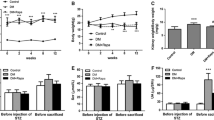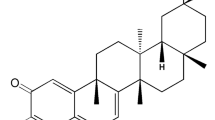Abstract
Background
Diabetic nephropathy (DN) is one of the most serious chronic complications of diabetes mellitus (DM). Autophagy is an important physiological function for podocytes to maintain stability of intracellular environment. In this study, we planned to clarify the effect of Cordycepin, a traditional Chinese medicine, on DN and the related mechanisms.
Methods
All rats were randomly divided into normal control group, diabetic controls, low-dose group (10 mg/kg), medium-dose group (100 mg/kg), and high-dose group (500 mg/kg). The level of cholesterol, blood sugar, triglyceride, creatinine, and urine protein was examined through an automatic biochemistry analyser. Enzyme-linked immunosorbent assay (Elisa) was used to detect the level of IL-1β, IL-6, and IL-18. HE staining was used to examine histopathologic changes. TUNEL staining was used to detected cell apoptosis. The expression of fibrosis markers α-SMA, t-TG, and TIMP-1, apoptosis-related proteins cleaved-caspase3, Bax and Bcl-2, autophagy markers Beclin1, light chain 3 (LC3)I/II, and p62 were evaluated by western blot.
Results
The level of cholesterol, blood sugar, triglyceride, creatinine, and urine protein in the diabetic controls was much higher than that in the normal control group. Obvious histopathology injuries were also found in DN model group. After Cordycepin treatment, all the above indexes were improved compared with the DN group and tissue damages were also alleviated. Further studies showed that Cordycepin suppressed cell apoptosis and renal fibrosis and rescued cell autophagy in DN rat model. Moreover, the results of our in vitro experiments showed that the addition of 3-methyladenine (3-MA, specific autophagy inhibitor) successfully abolished the protective effect of Cordycepin on renal fibrosis through inducing apoptosis and renal fibrosis. The above protective effects of Cordycepin were exhibited in a dose-dependent manner.
Conclusion
Cordycepin participated in the modulation of cell apoptosis, fibrosis, and autophagy induction in DN. Our study for the first time revealed that Cordycepin had a certain therapeutic effect on DN in rats through autophagy induction.




Similar content being viewed by others
Abbreviations
- DN:
-
Diabetic nephropathy
- DM:
-
Diabetes mellitus
- 3-MA:
-
3-Methyladenine
- HGF:
-
Hepatocyte growth factor
- T2D:
-
Type 2 diabetes
- TG:
-
Tripterygium glycoside
- STZ:
-
Streptozotocin
References
Lasaridis AN, Sarafidis PA (2003) Diabetic nephropathy and antihypertensive treatment: what are the lessons from clinical trials? Am J Hypertens 16:689–697
Kume S, Kitada M, Kanasaki K, Maegawa H, Koya D (2013) Anti-aging molecule, Sirt1: a novel therapeutic target for diabetic nephropathy. Arch Pharm Res 36:230–236
Mokdad AH, Ford ES, Bowman BA, Dietz WH, Vinicor F, Bales VS, Marks JS (2003) Prevalence of obesity, diabetes, and obesity-related health risk factors, 2001. JAMA 289:76–79
Chen J, Zhao D, Zhu M, Zhang M, Hou X, Ding W, Sun S, Bu W, Feng L, Ma S, Jia X (2017) Paeoniflorin ameliorates AGEs-induced mesangial cell injury through inhibiting RAGE/mTOR/autophagy pathway. Biomed Pharmacother 89:1362–1369
Forbes JM, Thallas V, Thomas MC, Founds HW, Burns WC, Jerums G, Cooper ME (2003) The breakdown of preexisting advanced glycation end products is associated with reduced renal fibrosis in experimental diabetes. FASEB J 17:1762–1764
Brownlee M (2001) Biochemistry and molecular cell biology of diabetic complications. Nature 414:813–820
Liang S, Jin J, Shen X, Jiang X, Li Y, He Q (2018) Triptolide protects podocytes via autophagy in immunoglobulin A nephropathy. Exp Ther Med 16:2275–2280
Lennon MB, Suhadolnik RJ (1976) Biosynthesis of 3′-deoxyadenosine by Cordyceps militaris. Mechanism of reduction. Biochim Biophys Acta 425:532–536
Khan MA, Tania M (2018) Cordycepin in anticancer research: molecular mechanism of therapeutic effects. Curr Med Chem 22(3):1021–1027
Li L, He D, Yang J, Wang X (2011) Cordycepin inhibits renal interstitial myofibroblast activation probably by inducing hepatocyte growth factor expression. J Pharmacol Sci 117:286–294
Ma L, Zhang S, Du M (2015) Cordycepin from Cordyceps militaris prevents hyperglycemia in alloxan-induced diabetic mice. Nutr Res 35:431–439
Yu SH, Dubey NK, Li WS, Liu MC, Chiang HS, Leu SJ, Shieh YH, Tsai FC, Deng WP (2016) Cordyceps militaris treatment preserves renal function in type 2 diabetic nephropathy mice. PLoS One 11:e0166342
Lee J, Cummings BP, Martin E, Sharp JW, Graham JL, Stanhope KL, Havel PJ, Raybould HE (2012) Glucose sensing by gut endocrine cells and activation of the vagal afferent pathway is impaired in a rodent model of type 2 diabetes mellitus. Am J Physiol Regul Integr Comp Physiol 302:R657–R666
Isobe K, Adachi K, Hayashi S, Ito T, Miyoshi A, Kato A, Suzuki M (2012) Spontaneous glomerular and tubulointerstitial lesions in common marmosets (Callithrix jacchus). Vet Pathol 49:839–845
Liu WY, Wang ZB, Wang Y, Tong LC, Li Y, Wei X, Luan P, Li L (2015) Increasing the permeability of the blood–brain barrier in three different models in vivo. CNS Neurosci Ther 21:568–574
Kang MK, Park SH, Kim YH, Lee EJ, Antika LD, Kim DY, Choi YJ, Kang YH (2017) Chrysin ameliorates podocyte injury and slit diaphragm protein loss via inhibition of the PERK-eIF2alpha-ATF-CHOP pathway in diabetic mice. Acta Pharmacol Sin 38:1129–1140
Geletu AH, Teferra AS, Sisay MM, Teshome DF (2018) Incidence and predictors of chronic kidney diseases among type 2 diabetes mellitus patients at St. Paul’s Hospital, Addis Ababa. Ethiopia. BMC Res Notes 11:532
Hu P, Chen W, Bao J, Jiang L, Wu L (2014) Cordycepin modulates inflammatory and catabolic gene expression in interleukin-1beta-induced human chondrocytes from advanced-stage osteoarthritis: an in vitro study. Int J Clin Exp Pathol 7:6575–6584
Liang SM, Lu YJ, Ko BS, Jan YJ, Shyue SK, Yet SF, Liou JY (2017) Cordycepin disrupts leukemia association with mesenchymal stromal cells and eliminates leukemia stem cell activity. Sci Rep 7:43930
Yong T, Chen S, Xie Y, Chen D, Su J, Shuai O, Jiao C, Zuo D (2018) Cordycepin, a characteristic bioactive constituent in Cordyceps militaris, ameliorates hyperuricemia through URAT1 in hyperuricemic mice. Front Microbiol 9:58
Sun T, Dong W, Jiang G, Yang J, Liu J, Zhao L, Ma P (2019) Cordyceps militaris improves chronic kidney disease by affecting TLR4/NF-kappaB redox signaling pathway. Oxid Med Cell Longev 2019:7850863
Hong T, Cui LK, Wen J, Zhang MH, Fan JM (2015) Cordycepin protects podocytes from injury mediated by complements complex C5b-9. Sichuan Da Xue Xue Bao Yi Xue Ban 46(173):178 (227)
Shin S, Lee S, Kwon J, Moon S, Lee S, Lee CK, Cho K, Ha NJ, Kim K (2009) Cordycepin suppresses expression of diabetes regulating genes by inhibition of lipopolysaccharide-induced inflammation in macrophages. Immune Netw 9:98–105
Tagawa A, Yasuda M, Kume S, Yamahara K, Nakazawa J, Chin-Kanasaki M, Araki H, Araki S, Koya D, Asanuma K, Kim EH, Haneda M, Kajiwara N, Hayashi K, Ohashi H, Ugi S, Maegawa H, Uzu T (2016) Impaired podocyte autophagy exacerbates proteinuria in diabetic nephropathy. Diabetes 65:755–767
Zhang Y, Zhao S, Wu D, Liu X, Shi M, Wang Y, Zhang F, Ding J, Xiao Y (2018) MicroRNA-22 promotes renal tubulointerstitial fibrosis by targeting PTEN and suppressing autophagy in diabetic nephropathy. J Diabetes Res 2018:4728645
Gong J, Jin J, Zhao L, Li Y, Li Y, He Q (2018) Tripterygium glycoside protects against puromycin amino nucleoside induced podocyte injury by upregulating autophagy. Int J Mol Med 42:115–122
Author information
Authors and Affiliations
Corresponding author
Ethics declarations
Conflict of interest
The authors have declared that no competing interest exists.
Additional information
Publisher's Note
Springer Nature remains neutral with regard to jurisdictional claims in published maps and institutional affiliations.
Rights and permissions
About this article
Cite this article
Cao, T., Xu, R., Xu, Y. et al. The protective effect of Cordycepin on diabetic nephropathy through autophagy induction in vivo and in vitro. Int Urol Nephrol 51, 1883–1892 (2019). https://doi.org/10.1007/s11255-019-02241-y
Received:
Accepted:
Published:
Issue Date:
DOI: https://doi.org/10.1007/s11255-019-02241-y




